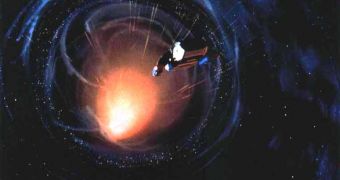Black holes have always sparked the imagination of many, scientists, sci-fi writers and common people alike, and many theories about their formation and especially about "what's on the other side?" Astrophysicists now have a pretty good idea about what they are, how they form and generally what makes them tick.
Or maybe not?
If you ask an astrophysicist what is a black hole, the answer will be more or less something like that: A black hole is an object with a gravitational field so powerful that no form of matter or radiation (including light) can escape once it is less than a certain distance from the center. As not even light can escape, black holes appear black (resulting in the name for these objects).
But there are some scientists that don't agree with this classical definition.
Physicists Thibault Damour of the Institut des Hautes Etudes Scientifiques in Bures-sur-Yvette, France, and Sergey Solodukhin of International University Bremen in Germany now say that these objects could be structures called wormholes instead.
A new study they performed claims that objects scientists think are black holes could instead be wormholes leading to other universes. This solution could help solve some controversial issues about black holes, like the black hole information paradox proposed by Stephen Hawking - it suggests that physical information could "disappear" in a black hole. It is a contentious subject for science since it violated a commonly assumed tenet of science, that information cannot be destroyed - but could also raise a whole lot of new questions.
A wormhole is a hypothetical topological feature of spacetime that is essentially a "shortcut" through space and time. A wormhole has at least two mouths which are connected to a single throat. If the wormhole is traversable, matter can "travel" from one mouth to the other by passing through the throat. While there is no observational evidence for wormholes, spacetimes containing wormholes are known to be valid solutions in general relativity.
The two scientists studied what such a wormhole might look like, and were surprised to discover that it would mimic a black hole so well that it would be virtually impossible to tell the difference.
A wormhole would attract matter into a giant whirlpool in the same way as for a black hole, since both objects distort the space around them in the same way.
The hope of distinguishing the two by something called Hawking radiation - an emission of particles and light which should only come from black holes and would have a characteristic energy spectrum - is also elusive. This radiation is so weak that it would be completely swamped by other sources, such as the background glow of microwaves left over from the big bang, making it unobservable in practice.
Another difference one might hope to exploit is that unlike black holes, wormholes have no event horizon. This means that things could go in a wormhole and come back out again. In fact, theorists say one variety of wormhole wraps back onto itself, so that it leads not to another universe, but back to its own entrance.
The conclusion is appealing mostly to sci-fi fans, as it's a little bit beyond our technological capabilities (and the willing to take risks). It seems the only way to decide the issue for sure with astronomical black holes is to make a daring plunge inside. That would be a dangerous gamble, because if it is a black hole, the incredibly strong gravitational field inside would tear apart every atom in your body. Even if it turns out to be a wormhole, the forces inside could still be deadly.

 14 DAY TRIAL //
14 DAY TRIAL //